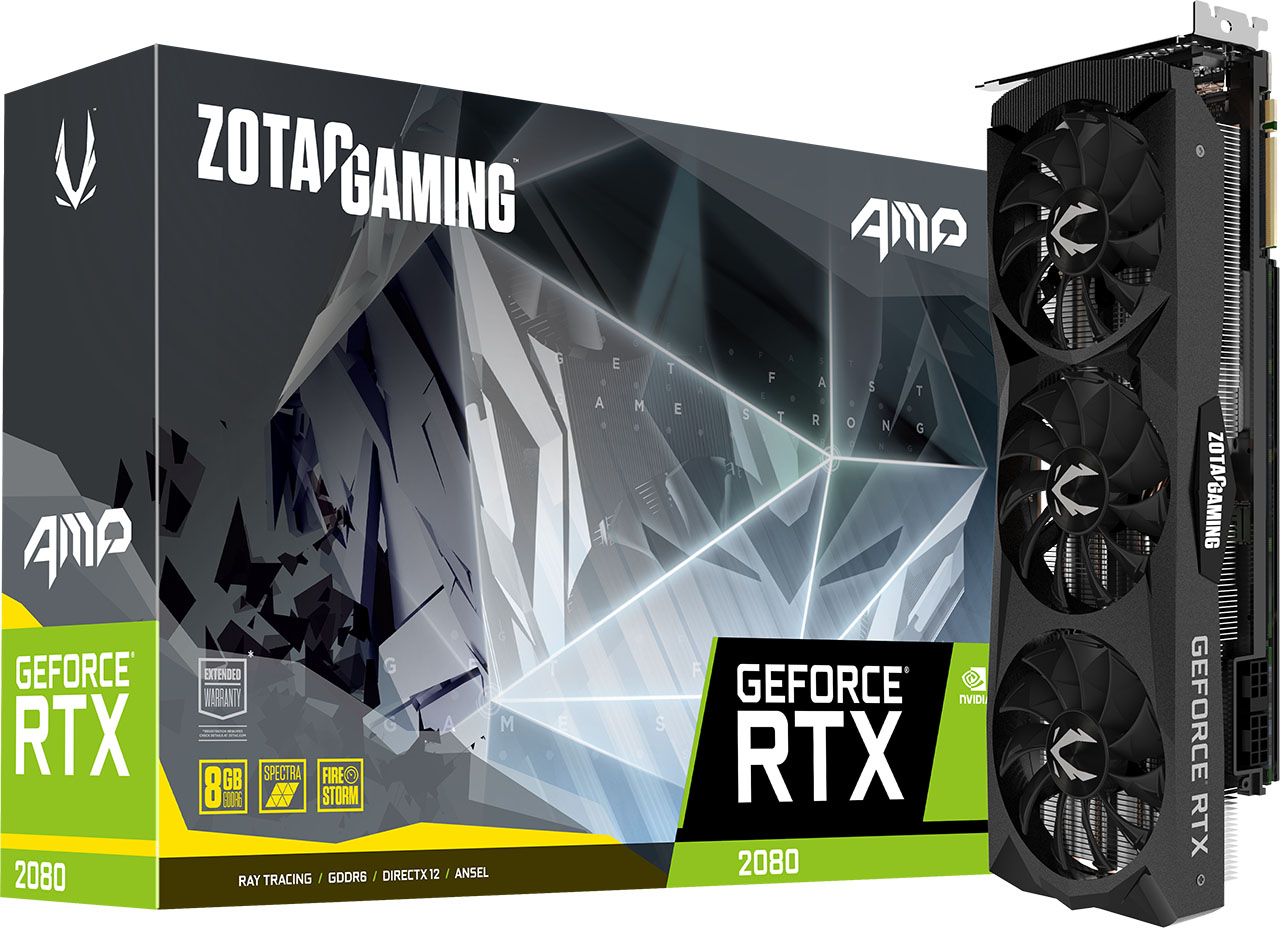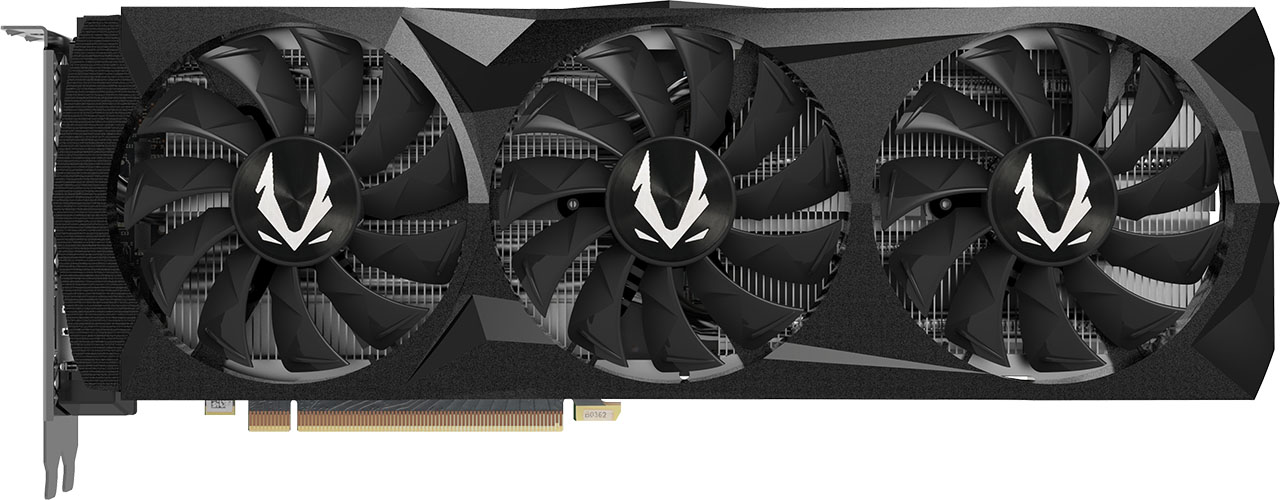Tom's Hardware Verdict
The Gaming GeForce RTX 2080 AMP offers similar performance to Nvidia's Founder's Edition, along with cooler temperatures. Inferior build quality is compensated for by a more affordable price tag.
Pros
- +
Runs cooler than GeForce RTX 2080 Founders Edition
- +
Higher GPU Boost rating than Nvidia's Founders Edition card
- +
Configurable lighting via bundled Firestorm app
- +
One of the least expensive GeForce RTX 2080 cards available
Cons
- -
Cheaper-feeling construction than Founders Edition card
- -
Triple-slot cooler takes up more space
Why you can trust Tom's Hardware
Zotac Gaming GeForce RTX 2080 AMP Review
Update, 11/22/18: Due to depleted inventory of GeForce GTX 1080 Ti cards and falling prices on third-party Turing-based models, we are revisiting our impressions of Zotac's Gaming GeForce RTX 2080 AMP and updating value comparisons throughout the review.
Zotac’s Gaming GeForce RTX 2080 AMP boasts a slightly-higher maximum GPU Boost clock rate and better cooling than Nvidia's GeForce RTX 2080 Founders Edition card. Conversely, while the Zotac board's performance is strong, its cheaper-feeling materials and the need to take up three expansion slots are notable drawbacks.
Our tests also show that you can get similar frame rates from a less-expensive, last-gen GTX 1080 Ti. But if you want smooth game play at 4K with dialed-back quality settings, along with support for next-gen features like ray tracing, the Gaming GeForce RTX 2080 AMP delivers.
Meet The Gaming GeForce RTX 2080 AMP
Size isn’t everything, but a bit of extra heft sure doesn’t hurt when you’re trying to keep a 13.6 billion transistor GPU running cool and quiet. Zotac’s Gaming GeForce RTX 2080 AMP is much larger than Nvidia’s Founders Edition model, measuring 12.13 x 4.45 x 2.24 inches. Of course, that makes it about two and half expansion slots thick, tying up three slots on your motherboard (along with more space in the other direction due to a taller backplate).
Don’t let the sizeable dimensions fool you, though. Whereas Nvidia’s Founders Edition card tips the scales at 1262g, Zotac’s Gaming GeForce RTX 2080 AMP is a noticeably lighter 1152g. Nvidia’s reference design is denser, more compact, and loaded with lots of metal.
Meanwhile, Zotac unashamedly uses plastic across its fan shroud, along with a less massive thermal solution. Gone is the vapor chamber, replaced by a base plate and two-part aluminum fin stack bisected by five 8mm copper heat pipes. Four pipes run the length of the card. A fifth sits directly over TU104 and loops around, dissipating heat through the left-most fin stack.
Under the sink, Zotac shores up this card’s rigidity with a metal baseplate that also makes contact with the power circuitry and memory modules via thermal pads. The plate acts as a skeleton of sorts, preventing flex by attaching directly to the expansion bracket up front and the fin stack around back. Ten screw holes around the PCB allow a backplate to sandwich the board, stiffening both sides. Unfortunately, the backplate plays no purpose in spreading heat away from TU104's package; it sits far above the rear-facing surface-mount components.
Get Tom's Hardware's best news and in-depth reviews, straight to your inbox.
A trio of 90mm axial fans is designed to blow turbulent air through the heat sink’s fins. Waste heat is pushed down toward the motherboard and out the card's top. Although Zotac’s black, plastic shroud does impede airflow somewhat, it doesn’t wrap completely around the cooler, leaving room for air to escape. The fans do not disengage completely at idle, which we’re fine with. Turning at around 1,100 RPM, they make no perceptible noise at all.
Zotac’s website draws attention to this card’s Spectra lighting. But the corresponding multi-color picture isn’t representative of the Gaming GeForce RTX 2080 AMP. On our sample, only the Zotac Gaming logo up top lights up. And the effects enabled through Zotac’s Firestorm utility are fairly limited.
The card’s top side also plays host to one six-pin and one eight-pin power connector. Nvidia’s reference RTX 2080 specification calls for 215W partner boards. However, Zotac's Gaming GeForce RTX 2080 AMP matches the Founders Edition version with a 225W power rating.
Whereas Nvidia covers its NVLink connector with a well-integrated plastic piece, Zotac leaves the interface exposed. The aesthetic difference certainly makes us appreciate Nvidia's attention to detail.
Display outputs on Zotac's card match the GeForce RTX 2080 Founders Edition: you get three full-sized DisplayPort 1.4 connectors, one HDMI 2.0 port, and VirtualLink support via USB Type-C. Zotac does use a more free-flowing grille back there, but it isn’t functionally significant since the cooler’s vertically-oriented fins move air perpendicular to the bracket.
| Header Cell - Column 0 | GeForce RTX 2080 Ti FE | Zotac Gaming GeForce RTX 2080 AMP | GeForce RTX 2080 FE | GeForce GTX 1080 Ti FE |
|---|---|---|---|---|
| Architecture (GPU) | Turing (TU102) | Turing (TU104) | Turing (TU104) | Pascal (GP102) |
| CUDA Cores | 4352 | 2944 | 2944 | 3584 |
| Peak FP32 Compute | 14.2 TFLOPS | 10.8 GFLOPS | 10.6 TFLOPS | 11.3 TFLOPS |
| Tensor Cores | 544 | 368 | 368 | N/A |
| RT Cores | 68 | 46 | 46 | N/A |
| Texture Units | 272 | 184 | 184 | 224 |
| Base Clock Rate | 1350 MHz | 1515 MHz | 1515 MHz | 1480 MHz |
| GPU Boost Rate | 1635 MHz | 1830 MHz | 1800 MHz | 1582 MHz |
| Memory Capacity | 11GB GDDR6 | 8GB GDDR6 | 8GB GDDR6 | 11GB GDDR5X |
| Memory Bus | 352-bit | 256-bit | 256-bit | 352-bit |
| Memory Bandwidth | 616 GB/s | 448 GB/s | 448 GB/s | 484 GB/s |
| ROPs | 88 | 64 | 64 | 88 |
| L2 Cache | 5.5MB | 4MB | 4MB | 2.75MB |
| TDP | 260W | 225W | 225W | 250W |
| Transistor Count | 18.6 billion | 13.6 billion | 13.6 billion | 12 billion |
| Die Size | 754 mm² | 545 mm² | 545 mm² | 471 mm² |
| SLI Support | Yes (x8 NVLink, x2) | Yes (x8 NVLink) | Yes (x8 NVLink) | Yes (MIO) |
What lives under the Gaming GeForce RTX 2080 AMP’s hood is already well-known. We dug deep into the TU104 graphics processor and its underlying architecture in Nvidia’s Turing Architecture Explored: Inside the GeForce RTX 2080. Zotac takes the same graphics processor with 2944 of its CUDA cores enabled and bumps the typical GPU Boost rating up slightly to 1830 MHz (versus the Founders Edition card’s 1800 MHz). Eight gigabytes of GDDR6 memory move data at 14 Gb/s, matching Nvidia’s reference design. As you might expect, then, performance comparisons between the two models fall within single-digit percentage variance.
How We Tested Zotac’s Gaming GeForce RTX 2080 AMP
While many users will attach Zotac's card to a system with the latest Intel or AMD processor, our graphics station still employs an MSI Z170 Gaming M7 motherboard with an Intel Core i7-7700K CPU at 4.2 GHz. The processor is complemented by G.Skill’s F4-3000C15Q-16GRR memory kit. Crucial’s MX200 SSD remains, joined by a 1.4TB Intel DC P3700 loaded down with games.
As far as competition goes, we can assume that GeForce RTX 2080 and all of the partner boards based on the same design are bested by GeForce RTX 2080 Ti and Titan V, both of which we have in our test pool. We also compare GeForce GTX 1080 Ti, Titan X, GeForce GTX 1080, GeForce GTX 1070 Ti, and GeForce GTX 1070 from Nvidia. AMD is represented by the Radeon RX Vega 64 and 56.
Our benchmark selection now includes Ashes of the Singularity: Escalation, Battlefield 1, Civilization VI, Destiny 2,Doom, Far Cry 5,Forza Motorsport 7, Grand Theft Auto V, Metro: Last Light Redux, Rise of the Tomb Raider, Tom Clancy’s The Division, Tom Clancy’s Ghost Recon Wildlands, The Witcher 3 and World of Warcraft: Battle for Azeroth.
The testing methodology we're using comes from PresentMon: Performance In DirectX, OpenGL, And Vulkan. In short, these games are evaluated using a combination of OCAT and our own in-house GUI for PresentMon, with logging via AIDA64.
All of the numbers you see in today’s piece are fresh, using updated drivers. For Nvidia, we’re using build 411.51 for GeForce RTX 2080 Ti and 2080. Zotac’s Gaming GeForce RTX 2080 AMP is tested on 411.70. The other cards were tested with build 398.82. Titan V’s results were spot-checked with 411.51 to ensure performance didn’t change. AMD’s cards utilize Crimson Adrenalin Edition 18.8.1, which was the latest at test time.
MORE: Best Graphics Cards
MORE: Desktop GPU Performance Hierarchy Table
MORE: All Graphics Content
Current page: Zotac Gaming GeForce RTX 2080 AMP Review
Next Page Performance Results: 2560x1440





